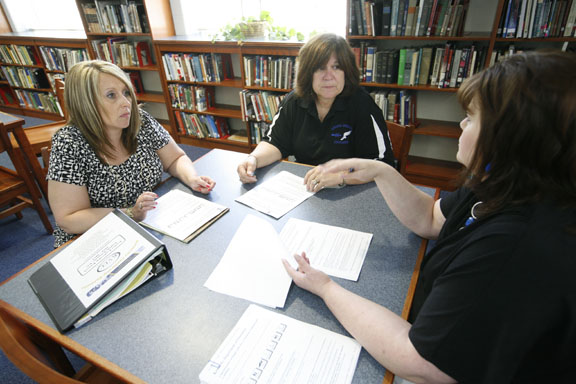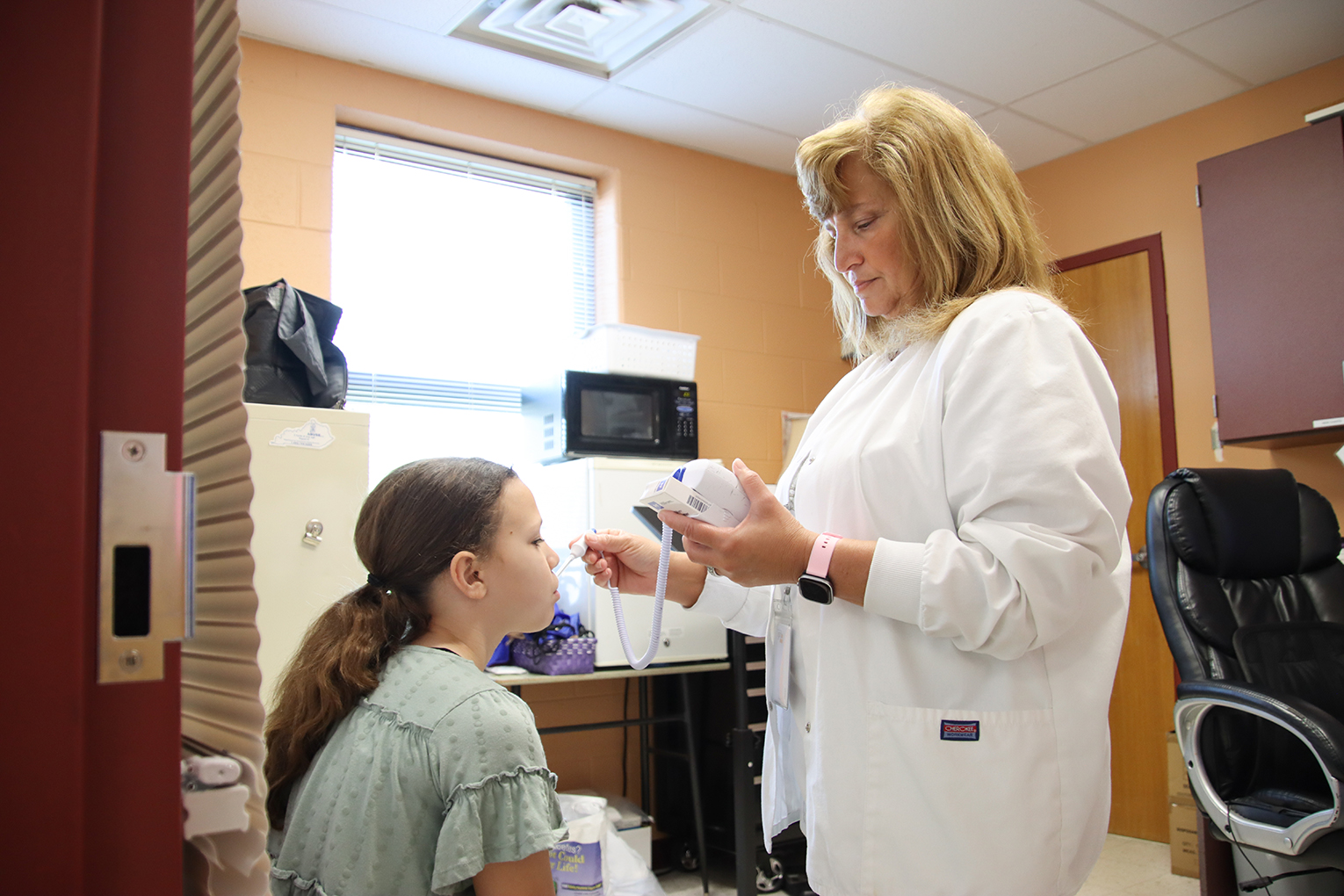
Letcher County Central High School language arts teacher Rebecca Potter, left, mathematics teacher Faye Collier, center, and Principal Denise Yonts discuss the new language arts standards Sept. 9, 2010. Teachers from across the state are spending this year transforming Kentuckyâs new Core Academic Standards into usable learning targets and developing the best ways to teach them. Photo by Amy Wallot
By Matthew Tungate
Teachers from across the state are spending this year transforming Kentucky’s new Core Academic Standards into usable learning targets – and developing the best ways to teach them.
Rebecca Potter, an 18-year veteran who teaches senior English and newspaper journalism at Letcher County Central High School, said integrating both content and technique can only benefit teachers.
“Often we are exposed to content and to quality teaching, but rarely at the same time. We take the content and combine (it) with the techniques that seem to work for us,” she said. “However, sometimes we can get stuck in a rut, and we don’t expose our students to a variety of techniques that may enhance their learning. Hopefully, this strategy will give us an opportunity to grow as teachers.”
“We need to make better teachers in every classroom regardless of what standards they’re teaching.”
Karen Kidwell, project manager for Leadership Networks,
Kentucky Department of Education
After 16 years in elementary and middle school education, Campton Elementary School (Wolfe County) teacher Daphne Patton believes that learning the new content and new techniques at the same time is a good approach.
“Unlike the gradual phase-in process of new techniques and/or strategies of the past, everyone should be receiving the same information to disseminate and process within their respective districts at the same time,” said Patton, who teachers 5th-grade social studies and language arts.
But how they process and disseminate that information will vary from district to district under the capacity-building model Kentucky is using to implement the new standards, according to Karen Kidwell, project manager for Leadership Networks at the Kentucky Department of Education.
The 2009 General Assembly mandated that Kentucky schools use new academic standards beginning with the 2011-12 school year. Earlier this year, Kentucky became the first state in the country to adopt mathematics and English/language arts standards that were developed by a multi-state consortium. The new standards, though fewer in number, are supposed to allow deeper instruction at the classroom level.
To help teachers learn and understand the new targets, the Kentucky Department of Education formed networks for school and district administrators and for teachers. Districts selected three teachers for each of the subject areas to receive training through the eight educational cooperatives. As members of the leadership networks, teachers are expected to:
- agree on the intent of the standards in terms of what students must demonstrate as evidence of success
- break down or deconstruct standards into clear learning targets
- design high-quality formative and summative assessments
- plan rigorous and congruent learning experiences for instruction
- select evidence-based strategies and resources to enhance instruction
- support other educators in their districts as they do these same processes
Kidwell said teachers in the networks, including Patton and Porter, will meet for six days during the year and again over the summer.
“The whole point of this is we’re developing district capacity,” she said.
Kidwell said teachers in the leadership network will test the techniques they are learning and work with their counterparts in the other two leadership networks to using existing mechanisms in each school and district to train their fellow teachers.
“This won’t look like a brand new thing necessarily,” she said.
Potter likes the capacity-building approach because more people are involved in the process.
“The team can make decisions together and present together,” she said. “People on that team become touchstones for others in the district as they begin the task of working with the new standards and learning more effective teaching strategies.”
Patton agreed.
“It seems that this time we are trying to build something from the ground up instead of just saying, ‘Okay. Here are your new standards – teach and good luck on the test,” she said. “Keeping teachers informed and part of the overall process can only be a good thing.”
Kidwell said the Department of Education is trying to make sure the best information, the best strategies and best resources are available to teachers.
“If it were all just a matter of handing people new standards, you could train them,” she said. “But our problem isn’t the standards; it wasn’t even the old standards. The problem was we need to impact classroom practice. We need to make better teachers in every classroom regardless of what standards they’re teaching.
Kidwell said the Department of Education, based on the leadership networks’ work, will try to provide resources for teachers, including:
- learning progressions
- learning targets
- aligned assessment items
- model lesson plans/learning experiences
- sample course designs, especially for high school
- crosswalks
Because the new standards won’t be assessed until the 2011-12 school year, teachers should have time to learn the new standards and the improved teaching techniques, Kidwell said.
Porter said teachers are anxious about reconfiguring their teaching to meet the new standards. That’s why she thinks they will benefit from the work of the leadership networks.
“I think teachers will have a deconstructed curriculum that they can pick up and use,” she said. “They will know what it will take to make their students career and college ready.
Kidwell expects the leadership networks to have broken the standards into key learning targets by December. Many of the standards are already very understandable, Kidwell said. But some of the standards are taught in different grades than they have been, so “a lot of people are going to be asked to teach things they’ve never taught in the past.”
“With the standards being more rigorous and kind of shifting down, that’s going to be new content to many teachers, so we really want to take the time on the front end to make sure we are building content knowledge as well,” she said.
Patton said teachers should remember that the changes in the standards and teaching techniques aren’t that different from what they have been doing.
“Much of the content we are teaching is still very much in place. Adjustments will need to be made as far as when concepts are introduced, taught, mastered, reinforced, etc.,” she said. “The biggest change for me so far seems to be not in the way we teach, but the way we assess our students. Learning to better assess my students will make me a better teacher. Also, the support we will receive as far as teaching strategies and techniques will help many to become more comfortable from the onset with the new materials.”
MORE INFO …
Karen Kidwell, karen.kidwell@education.ky.gov, (502) 564-2106




Leave A Comment